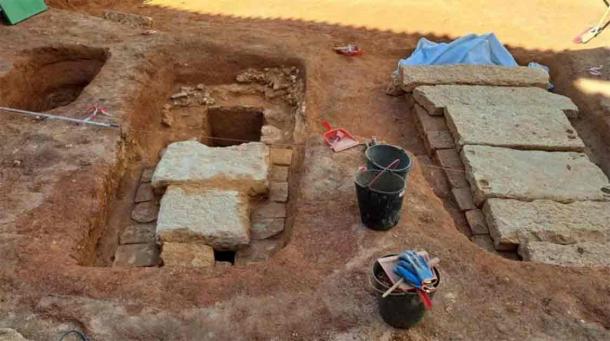Archaeological excavations in Portugal’s central Faro, the country’s southernmost city, have unearthed three graves from the ancient Roman city of Ossonoba, possibly indicating a familial connection, pending DNA testing confirmation. The initial excavation revealed a fully intact skeleton of a man aged between 39 and 45 years old. Beside him lay the remains of a young woman, estimated to be under 25 years old, and an infant no older than six months!
The baby’s skeleton, with an undetermined gender, was found with only the upper half intact alongside a highly fragmented skull. Despite this, archaeologists successfully retrieved all of the baby’s teeth, which were yet to emerge, providing crucial insight into the age at which the infant perished.
Looted Graves, A Wealthy Family Burial?
According to one of the project’s lead archaeologists, Francisco Correia, the graves can be dated back to the fifth and sixth centuries, and are devoid of any significant artifacts, reports Postal. While the man’s grave remained untouched, signs of disturbance were evident in the other two, possibly indicating looting, which is not uncommon.

The proximity of the graves suggests a familial connection among the three individuals buried within. (ERA Arqueologia)
A team of archaeologists from ERA Arqueologia is currently conducting excavations across a 5,000 square meter (53, 819.55 sq ft) area slated for future real estate development. The site of their investigation is an erstwhile truck repair workshop, where the aforementioned discoveries have been made.
“The graves will have been the target of some kind of spoliation that led to the disruption, and even the destruction of some anatomical positions of the skeletons, mainly, that of the child, who was very much altered,” speculated biological anthropologist Claudio Maio.
Indications suggest that the individuals buried in the discovered graves likely belonged to a wealthy socio-economic stratum. Their burials were not in open ditches, and the graves showed signs of care, with the bodies being buffered by limestone slabs, possibly repurposed from doorposts of a monumental building, reports Arkeonews. The proximity to each other indicates familial status, though this is by no means a conclusive statement.
To deepen their understanding, the researchers are eager to employ DNA testing and isotopic analysis techniques. DNA tests will offer insights into familial relationships and potential genetic predispositions. Meanwhile, isotopic analysis will shed light on population movements and dietary habits by examining chemical traces within the ancient human remains.

The researchers aim to offer more accurate insights using DNA testing and isotopic analysis methods. These techniques can decipher population movements and dietary patterns from chemical residues in ancient human bones. (ERA Arqueologia)
Additional Finds: A Significant Coin, a Brilliant Mosaic
In addition to the graves, the team uncovered a wealth of artifacts, providing further insights into the daily lives and activities of the ancient inhabitants. Among the discoveries were dozens of coins, including one remarkably well-preserved specimen minted during the reign of Emperor Constantine I the Great (307-337 AD).

Roman artifacts, including coin minted during the reign of Emperor Constantine the Great. (ERA Arqueologia)
Additionally, they unearthed a bone die, nails, pins, a spoon, amphorae, carvings, and numerous intricately decorated ‘sigillata’ ceramic pieces. This type of high-quality ceramic was typically associated with the elites of the time.
Further exploration of the southernmost area of the site revealed a Roman structure consisting of small complexes, with evidence of metallurgical production found alongside a significant concentration of crushed shells. These shells were likely utilized in the extraction of pigment for textile coloring, shedding light on the industrial activities that once took place in the vicinity.
Interestingly, the same area had yielded a significant discovery in the 1920s: a mosaic from the 2nd century dedicated to the god Oceanus. This mosaic, rediscovered in 1976, is hailed as one of the best-preserved Roman mosaics in the southern region of the country and was designated a national treasure in 2018!
Francisco Correia noted that the closest ancient monumental building to the excavation area, likely part of a residential or industrial complex, is where the Oceanus mosaic was found. It is speculated to have housed an association of traders involved in maritime commerce. In addition to the graves, the excavation uncovered hundreds of small fragments hinting at the presence of another mosaic in the vicinity.
Ossonoba’s Archaeological Record: An Ancient and Medieval Settlement of Repute
The archaeological record of Ossónoba traces back to the 4th century BC, with the arrival of the Phoenicians in the Western Mediterranean. Initially named Ossónoba, the city witnessed various dominations over the centuries.
From the 2nd century BC until the 8th century AD, Ossónoba came under the control of both Roman and Visigothic powers. However, in 713, the city fell to Muslim conquest and was absorbed into the Islamic Caliphate of Cordoba. This complex history of diverse cultural influences shaped Ossónoba into a significant urban center throughout antiquity.
Top image: The graves, unearthed by a team from ERA Arqueologia in Portugal, held the remains of a man, a young woman, and an infant, all interred beneath limestone slabs believed to have been repurposed from monumental structures from the ancient city of Ossónoba. Source: ERA Arqueologia
By Sahir Pandey
References
Altuntas, L. 2024. Three Roman Graves Uncovered in Portugal. Available at: https://arkeonews.net/three-roman-graves-uncovered-in-portugal/.
Pires, B.F. 2024. Three Roman tombs unearthed in Faro. Available at: https://www.portugalresident.com/three-roman-tombs-unearthed-in-faro/.
Postcard. 2024. Archaeological excavations uncover three graves of the ancient Roman city of Ossonoba. Available at: https://postal.pt/cultura/escavacoes-arqueologicas-descobrem-tres-sepulturas-da-antiga-cidade-romana-de-ossonoba/.
Radley, D. 2024. Three Roman tombs uncovered in southern Portugal. Available at: https://archaeologymag.com/2024/04/three-roman-tombs-uncovered-in-southern-portugal/.





